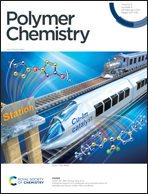An environmentally benign post-polymerization functionalization strategy towards unprecedented poly(vinylamine) polyHIPEs†
Abstract
Interconnected highly porous poly(vinylamine) monoliths are produced by post-polymerization hydrolysis of emulsion-templated poly(N-vinylformamide) polyHIPEs (polymerized high internal phase emulsions). Unlike previous work, in which polyHIPEs were amine-functionalized only to a small extent, our approach includes the hydrolysis of the formyl groups of the highly porous poly(N-vinylformamide) monolith, resulting in an exceptionally high degree of amine-functionalization, i.e. up to 10 mmol of primary amine functional groups per gram or 12 mmol of nitrogen per gram of polyHIPE. Importantly, this post-polymerization functionalization strategy preserves the polyHIPE features, such as morphology, porosity and three-dimensional (3D) interconnectivity and is carried out without the use of hazardous organic solvents, toxic amine reagents or catalysts. The resulting poly(vinylamine)-polyHIPEs exhibit pH-responsive swelling and water absorption behaviour and prove to be promising candidates for metal ion capture. Overall, the reported post-functionalization strategy is attractive for the production of unprecedented, high-density, primary amine-functionalized 3D-interconnected porous organic foams, materials of great interest for further derivatization and use in numerous applications.



 Please wait while we load your content...
Please wait while we load your content...